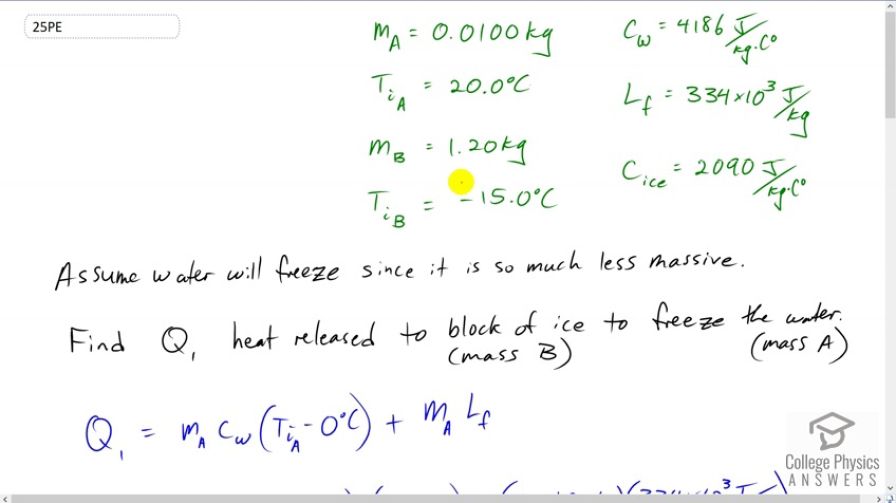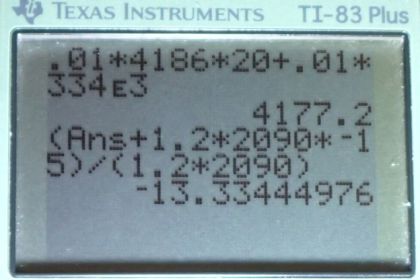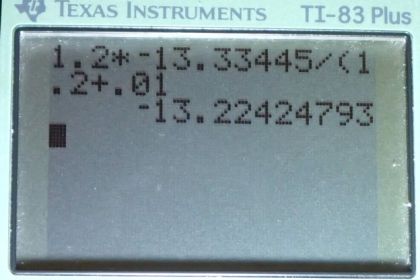Question
If you pour 0.0100 kg of water onto a 1.20-kg block of ice (which is initially at ), what is the final temperature? You may assume that the water cools so rapidly that effects of the surroundings are negligible.
Final Answer
Solution video
OpenStax College Physics for AP® Courses, Chapter 14, Problem 25 (Problems & Exercises)

vote with a rating of
votes with an average rating of
.
Calculator Screenshots
Video Transcript
This is College Physics Answers with Shaun Dychko. We have .01 kilograms of water, which is at 20 degrees Celsius, being poured onto an ice cube, which is at negative 15 degrees Celsius, and has a mass of 1.2 kilograms. Now, the question is: “what’s the final temperature of this combination?” And there’s gonna be two stages to the question. In the first stage, we’re going to look at the energy released by this water as it cools to zero degrees Celsius, and then freezes. So it’s going to be some heat of fusion released during the phase change from liquid to solid, and plus there’s going to be some heat released due to the temperature change from 20 degrees Celsius to zero. And then, we’ll take that amount of heat that it loses and we’ll say all that heat is being gained by the ice block, and so what will the temperature of the ice block be after absorbing all of the heat from the liquid’s temperature change, plus phase change? So that’s the first part of the question. And the second part of the question will be, after we have these, we now have these two blocks of ice: mass A, and the big block, mass B. Mass A is at zero degree Celsius, and it’s finished freezing now, so it’s ice block, we call mass A. And then, mass B is at some temperature that we had just figured out from the calculation of the first part of the question. And then, what will the final temperatures of these two blocks of ice be? Given this temperature of block B and zero degrees for block A, and knowing their different masses. Okay, so, let’s get started. We can make an assumption that it’s -- the final state of the system is going to be solid just because the mass of mass A is two orders of magnitude less than the mass B. So it’s much, much less massive. And so, we can assume that the energy released by mass A going to zero degrees, and then changing its phase is going to be much less than the energy that will be gained by mass B, as it increases its temperature. So mass A will entirely change to solid, and mass B will remain as solid. And if you don’t want to make that assumption, you want to do some calculations to determine what T final state will be, then what you would want to do is: find out how much energy it would take for mass B to become a liquid; and then compare that to the amount of energy it would take mass A to become a solid; and the one that requires much more energy is going to be the final state of the system. So, yeah. It’s going to be very difficult to turn mass B into liquid whereas it’s easy to turn mass A into a solid, because mass A is much less massive. Even though it has a slightly higher temperature, that’s not going to make that much of a difference to compensate for the significantly lower mass. Okay. So, we’ll figure out how much heat is released by the mass A, and that’s going to be released to the block of ice so block— mass B is going to receive this heat, and mass A is going to get frozen. So, we have this temperature change from 20 degrees Celsius to zero, and we’re multiplying by mass A and the specific heat of water, and then we’ll add to that the heat of fusion. So that’s mass A times the latent heat of fusion for water. So that’s .01 kilograms times 4186 Joules per kilogram per Celsius degree, times 20 Celsius degrees, plus .01 kilograms times 334 times 10 to the three Joules per kilogram: that’s the latent heat of fusion. And this means 4177.2 Joules of energy are released from mass A to mass B. So now let’s figure out what the temperature of mass B is going to become after receiving all this energy. So I have Q1 here, and Q1 there because these are the same quantities. They are same energies. So this is the energy that mass A is losing, and that’s going to be gained by mass B. And so we have: mass B times the specific heat of ice (because mass B is ice). And then multiplied by the change in temperature, so its final temperature minus its initial temperature. And then we’ll distribute these factors into the brackets and then switch the sides around. We’re solving for Tf prime here. And I gave it a prime, because this isn’t the final temperature of mass B for our question: this is just an intermediate temperature. If you recall a picture that I drew here, we have mass A in contact with mass B, and mass B is gonna have a temperature that it begins at, and mass A will have a temperature of zero degrees Celsius, so this is the moment just when mass A has finished changing phase. And now these two blocks of ice are in contact with each other, what will their final temperature be? That’s the question that we’re going to get to in a second, and currently we’re determining this temperature that mass B starts at for this moment in time when mass A has just become solid. So, we’ll add this to both sides: mass B, C ice, and T initial for mass B. And then we’ll divide both sides by mass B and specific heat of ice. And we end up with this line here. So the final temperature for mass B after mass A has finished changing its phase to ice at zero degrees Celsius is going to be: Q1, the heat released by mass A as it went 20 degrees to zero, and then also changed state, and plus mass B, specific heat of ice, times mass B’s initial temperature, divided by mB, C ice. So it’s 4177.2 Joules plus 1.2 kilograms, times 2090 Joules per kilogram per Celsius degree, times negative 15 degrees Celsius (initial temperature for mass B), divided by 1.2 kilograms times 2090 Joules per kilogram per Celsius degree. And this is the temperature of negative 13.33445 degrees Celsius. I’m keeping lots of digits in this number because it’s an intermediate calculation, and we don’t want to do intermediate rounding error. So we won’t round this number. And you never round until a final answer. So, and now we have – now we finally have this picture, where Tf prime is 13 point something, something, something; and then mass A is zero; and what will their final temperatures be. So we’re gonna have the heat loss by frozen mass A is gonna equally heat gained by mass B, and they’re gonna have the same final temperature. Because they’re isolated in contact with each other. Now, this part in green here is explaining why for mass A have initial temperature minus final temperature, which is the opposite that you would normally expect when you have a delta something. So we have Delta temperature, and Delta T means T final minus T initial. It’s always final minus initial when you have a Delta. But in this case, we’re going initial minus final because for mass A it’s going to be losing energy, and so we want a negative Q of mass A on one side, and then positive Q of mass B on the other side because mass B is going to be gaining energy. And so we have positive Q. And putting a negative in front of this Q puts a negative here in negative mc, T final minus T initial, but we can write it as positive mc, T initial minus T final, by multiplying through by this negative sign. And so it changes the sign of each of the terms inside the bracket to mc times T initial minus T final. And this is true for heat being lost by something. Coz the formula we’re given is the heat gained by something, and so by putting a negative in front of it, we change it to this form. And so, that’s what we write here. So we have mass A, times specific heat of ice, times initial temperature of zero minus some final temperature that we’re trying to find, equals mass B, times specific heat of ice, times final temperature minus mass B’s initial temperature for this portion of the problem. And so, this is the temperature that we calculated up here: the temperature of mass B after mass A became ice at zero degrees Celsius. So, we’ll distribute into the brackets in both these cases, and we’re solving for T f. Now, these factors multiplied by zero makes zero, which is nice. So we just have a negative mA, C ice, T final for here. And on the right hand side we have: mB, C ice, T final minus mB, C ice, T final prime. And then I’ll move this term to the right hand side, which makes it positive. And move this term to the left hand side which also makes it positive, and then switch the sides around so that we have the unknown on the left. So we have: mB, C ice, T final minus mA, C ice, T final. So it’s this term plus this term. And then equals mB, C ice, T final prime. And then factor out the T final from both those terms. And we have T final, and then C ice is also a common factor so that comes out of the brackets, times mB plus mA, equals mB, C ice, T final prime. And then divide both sides by C ice, times the sum of the masses. And then you have, the T final is mass B times the temperature that we determined in the first part of the solution, divided by mB plus mA. So it’s 1.2 kilograms, times negative 13.33445 degrees Celsius, divided by 1.2 kilograms plus .0100 kilograms. And this gives negative 13.2 degrees Celsius. And so we can see that the amount of heat exchanged changing the temperatures of the two blocks of ice was not very significant, because it brought the mass B from negative 13.3 to negative 13.2 degrees Celsius. Whereas changing the phase of a liquid into solid did have a significant change on block B’s temperature, taking it from negative 15 to negative 13.3. So, give yourself a pat on the back if you followed that whole solution. That was a long one and challenging, but you got this far. Good job!

